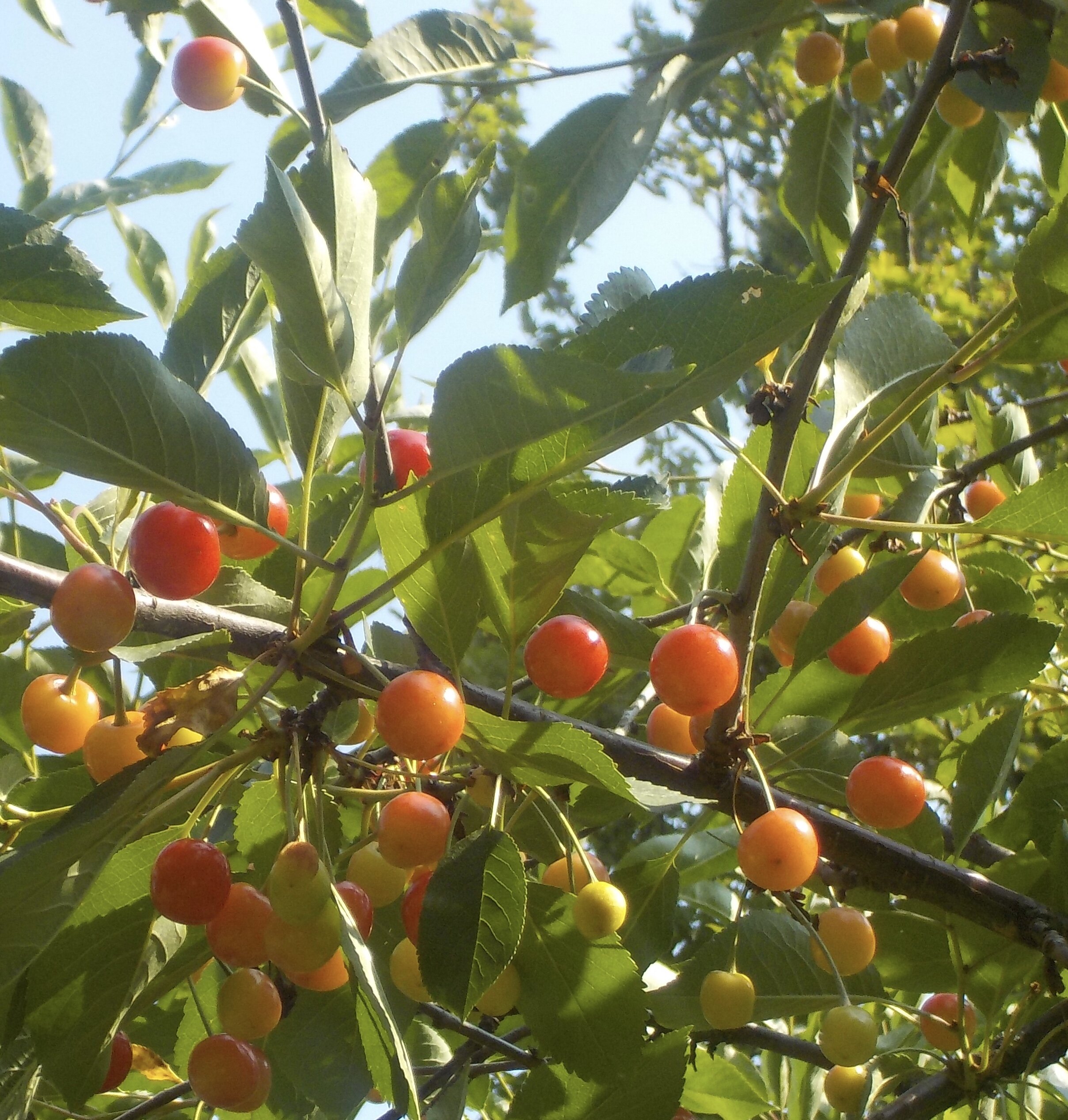To Repair Our Lives - The Fullness of July, Beginning of August 2021
The Season of Ripening (and invitation for your input)
I have been scrutinizing the ripening tart pie cherries daily - sometimes hourly. Watching as the fruit changes from hard green ball to softer yellow — now blushing its way into bright red. I watch for the deep brown spots that are shadowed beneath the skin, signaling mush and decomposition for many of the fruit.
It’s a relatively old tree — gifted to Jeff for Father’s Day when our now adult sons were small. The tree has been through a lot: the building of a raised flower bed around it meant soil too high on its trunk, rather than letting large top roots bask in sunlight. Branches were broken or cut to allow family ball games and gatherings. Pruning didn’t happen, or happened incorrectly. Leaf spot diseases showed up. Some years there were very few berries.
Finally, four years ago I considered cutting the cherry tree down and replacing it. When I spoke of my sadness, young resourceful farm workers suggested crafting a cherry-wood spoon keepsake from the tree after it was downed.
But the next year - fruit… and lots of it! But brown rot… and lots of it! The brown would start as a tiny inner insect spot. Some of the fruit would grow and ripen faster than the spot, and we harvested and shared those. However, much of the harvest was lost to the rot.
It happened again the next year, worse. I did not share cherries that year. I called our county extension agent (also an experienced farmer). It was a beetle, like the plum curculio.
We’d have to prune away as much dead and contaminated tree as possible — up to one-third of the tree. We’d have to collect every fallen leaf and dried cherry from the surrounding soil. Otherwise, the insect source of the rot would winter over in the debris and soil, and continue the infection and re-infection.
Jeff pruned the tree hard. It hurt to see so many limbs cut away.
I and helpers combed beneath the tree, clearing the soil until it was bare, even as we knew it was impossible to eliminate all traces of infection.
The next year, buckets of beautiful sour cherries; but also buckets of brown-spotted cherries. We cleared again, on our hands and knees on the fall-cooled earth — determined to break the cycle.
This year — cherries round and gleaming. Many to share and eat, apparently blemish-free.
There are, however, a sprinkling of brown spots. Some fruit will be ruined for human nourishment.
We will have to prune and clear thoroughly this fall, and perhaps for as long as we live and love on this land. To maintain health and sustainability we will tend the tree. Its brokenness, resilience, fruit, gifts, and history will be supported and celebrated. This with the knowledge that the rot is opportunistic and always possible even when it appears to be eliminated.
Do I repair the tree and the surrounding soil for once and for all? No, the repair is ongoing.
This time of year is full of so much growth and ripening. Last month was ripe with pronouncements of freedoms. There were the fireworks of July 4th - the United States of America’s Independence Day. A month earlier, there were the honoring, growings, and teachings of June 19th - Juneteenth, the day the last slaves in Texas received word that they were liberated (more than two years after the Emancipation Proclamation!).
As history and current events unfold, it is clear that for all our pronouncements, proclamations, and celebrations — the concept of justice and liberty for all is yet ripening. It is not a completed harvestable fruit.
In fact, we reel with the shock that the roots and impact of race-based slavery, removals, mistreatments, and exploitation still surface terrifyingly today. And this after the progress of civil rights movements, constitutional amendments, and a U.S. president of African descent, and a current vice president holding the intersections of multiple marginalized peoples.
Perhaps the love and tending of our bedraggled tart cherry tree hold a lesson. We are a country founded upon some things that rot and consume us from the inside out, some things that burrow and multiply unseen in our soils and souls.
Can we commit to a tenacious, hard, reparative love that examines, purges, and clears away over and over… even in the seasons when all seems shiny and beyond blemish?
How might the examination and clearing look? Possibly different for each of us.
- participate in groups of loving challenge and support about race, equity and our own
blind spots and defenses
- being neighbor to people of a variety of races and genders
- paying courageous and humble attention to interactions surrounding us
- relationship development across racial, gender, and other lines that respectfully seek
permission for honest questions and perspective
- taking the risk of encountering history and current experiences through varied lenses
- bearing witness in groups and alone (if need be) to the hard changes necessary at micro
personal and macro institutional and societal levels
- kneeling on the earth until our knees know the dampness, humbleness, and prayer of humus, and the teachings of trees.
In the heart of an overflowing growing season I hesitate to offer this invitation. But I also believe deeply in wisdom that grows from community. So here it is — the invitation:
If you have suggestions for, or experience with resources that can facilitate or inspire the ongoing reparative work called for, please send them to me by August 12th. I will capture the list and share it with the To Repair Our Lives sharers and responders.
Thank you for traveling with me on the journey.
~ regina
rmlaroche©2021 www.DiasporaOnMadeline.com

